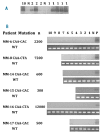Identification of translocation products but not K-RAS mutations in memory B cells from patients with multiple myeloma
- PMID: 20511669
- PMCID: PMC2948099
- DOI: 10.3324/haematol.2010.024778
Identification of translocation products but not K-RAS mutations in memory B cells from patients with multiple myeloma
Abstract
Background: Several laboratories have shown that cells with a memory B-cell phenotype can have the same clonotype as multiple myeloma tumor cells.
Design and methods: The aim of this study was to determine whether some memory B cells have the same genetic alterations as their corresponding multiple myeloma malignant plasma cells. The methodology included sorting multiple myeloma or memory B cells into RNA stabilizing medium for generation of subset-specific polymerase chain reaction complementary DNA libraries from one or 100 cells.
Results: Cells with the phenotype of tumor plasma cells (CD38(++)CD19(-)CD45(-/+)CD56(-/+/++)) or memory B cells (CD38(-)/CD19(+)/CD27(+)) were isolated by flow activated cell sorting. In samples from all four patients with multiple myeloma and from two of the three with monoclonal gammopathy of undetermined significance, we identified memory B cells expressing multiple myeloma-specific oncogenes (FGFR3; IGH-MMSET; CCND1 high) dysregulated by an IGH translocation in the respective tumor plasma cells. By contrast, in seven patients with multiple myeloma, each of whom had tumor plasma cells with a K-RAS61 mutation, a total of 32,400 memory B cells were analyzed using a sensitive allele-specific, competitive blocker polymerase chain reaction assay, but no K-RAS mutations were identified.
Conclusions: The increased expression of a specific "early" oncogene of multiple myeloma (monoclonal gammopathy of undetermined significance) in some memory B cells suggests that dysregulation of the oncogene occurs in a precursor B-cell that can generate memory B cells and transformed plasma cells. However, if memory B cells lack "late" oncogene (K-RAS) mutations but express the "early" oncogene, they cannot be involved in maintaining the multiple myeloma tumor, but presumably represent a clonotypic remnant that is only partially transformed.
Figures





Similar articles
-
Circulating clonotypic B cells in multiple myeloma and monoclonal gammopathy of undetermined significance.Haematologica. 2014 Jan;99(1):155-62. doi: 10.3324/haematol.2013.092817. Epub 2013 Jul 19. Haematologica. 2014. PMID: 23872308 Free PMC article.
-
The presence of circulating clonal CD19+ cells in multiple myeloma.Leuk Lymphoma. 2001 Nov-Dec;42(6):1359-66. doi: 10.3109/10428190109097764. Leuk Lymphoma. 2001. PMID: 11911420 Review.
-
In multiple myeloma clonotypic CD38- /CD19+ / CD27+ memory B cells recirculate through bone marrow, peripheral blood and lymph nodes.Leuk Lymphoma. 2004 Jul;45(7):1413-7. doi: 10.1080/10428190410001655157. Leuk Lymphoma. 2004. PMID: 15359642
-
Phenotyping studies of clonotypic B lymphocytes from patients with multiple myeloma by flow cytometry.Arch Pathol Lab Med. 2009 Oct;133(10):1594-9. doi: 10.5858/133.10.1594. Arch Pathol Lab Med. 2009. PMID: 19792049
-
Drug resistance in multiple myeloma: novel therapeutic targets within the malignant clone.Leuk Lymphoma. 1999 Jan;32(3-4):199-210. doi: 10.3109/10428199909167381. Leuk Lymphoma. 1999. PMID: 10037018 Review.
Cited by
-
Validation and implementation of a method for microarray gene expression profiling of minor B-cell subpopulations in man.BMC Immunol. 2014 Jan 31;15:3. doi: 10.1186/1471-2172-15-3. BMC Immunol. 2014. PMID: 24483235 Free PMC article.
-
Circulating clonotypic B cells in multiple myeloma and monoclonal gammopathy of undetermined significance.Haematologica. 2014 Jan;99(1):155-62. doi: 10.3324/haematol.2013.092817. Epub 2013 Jul 19. Haematologica. 2014. PMID: 23872308 Free PMC article.
-
A Comprehensive Review of the Genomics of Multiple Myeloma: Evolutionary Trajectories, Gene Expression Profiling, and Emerging Therapeutics.Cells. 2021 Aug 2;10(8):1961. doi: 10.3390/cells10081961. Cells. 2021. PMID: 34440730 Free PMC article. Review.
-
Prognosis of young patients with monoclonal gammopathy of undetermined significance (MGUS).Blood Cancer J. 2021 Feb 1;11(2):26. doi: 10.1038/s41408-021-00406-6. Blood Cancer J. 2021. PMID: 33563898 Free PMC article.
-
The genetic architecture of multiple myeloma.Nat Rev Cancer. 2012 Apr 12;12(5):335-48. doi: 10.1038/nrc3257. Nat Rev Cancer. 2012. PMID: 22495321 Review.
References
-
- Malpas JS, Bergsagel DE, Kyle RA, Anderson KC. Myeloma: Biology and Management. Third ed. Philadelphia: Saunders; 2004.
-
- Bakkus MH, Van Riet I, Van Camp B, Thielemans K. Evidence that the clonogenic cell in multiple myeloma originates from a pre-switched but somatically mutated B cell. Br J Haematol. 1994;87(1):68–74. - PubMed
-
- Caligaris-Cappio F, Bergui L, Gregoretti MG, Gaidano G, Gaboli M, Schena M, et al. Role of bone marrow stromal cells in the growth of human multiple myeloma. Blood. 1991;77(12):2688–93. - PubMed
-
- Chen BJ, Epstein J. Circulating clonal lymphocytes in myeloma constitute a minor subpopulation of B cells. Blood. 1996;87(5):1972–6. - PubMed
Publication types
MeSH terms
Grants and funding
LinkOut - more resources
Full Text Sources
Medical
Research Materials
Miscellaneous

